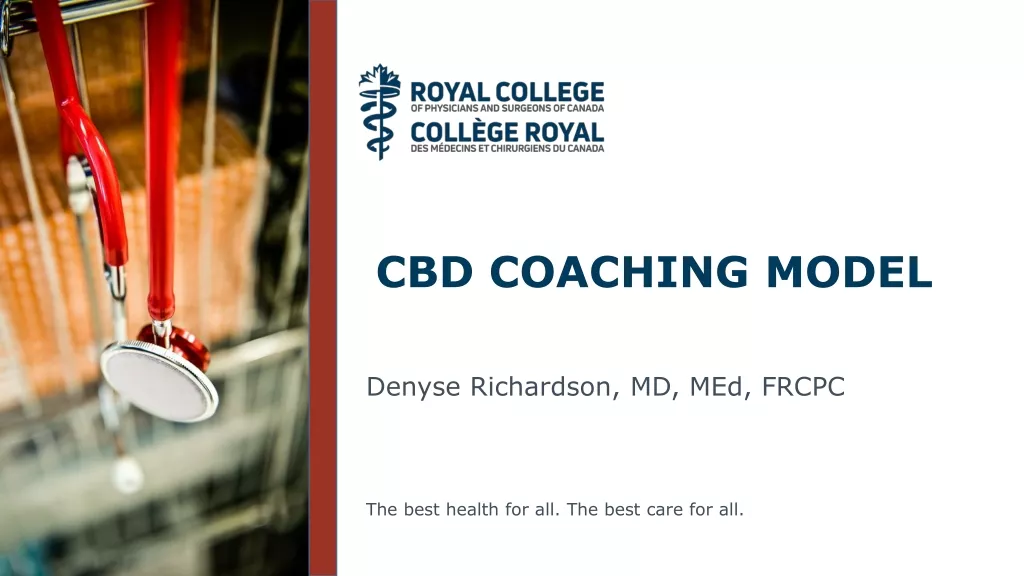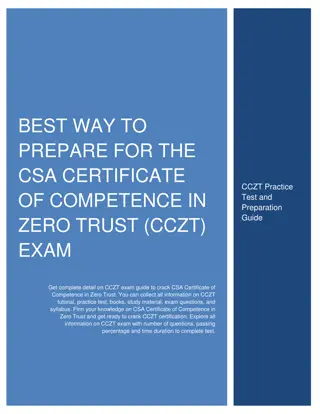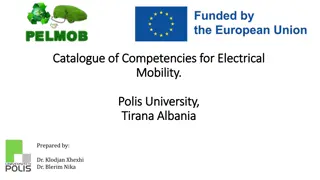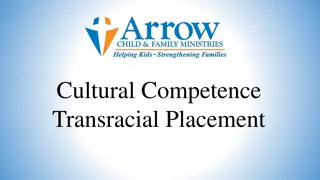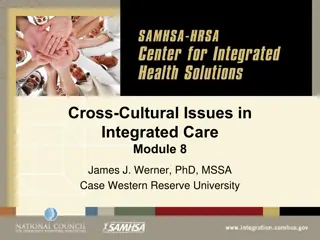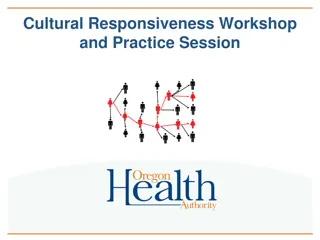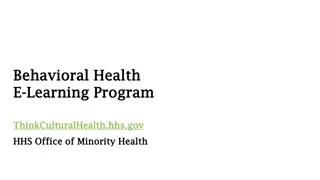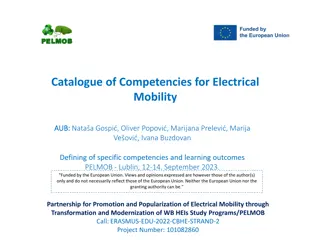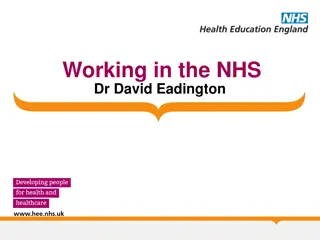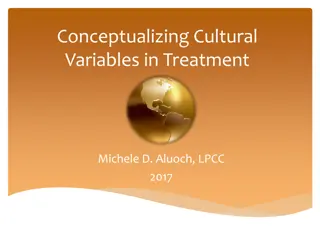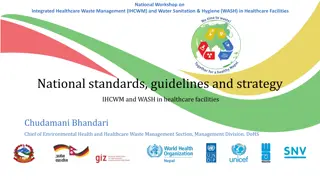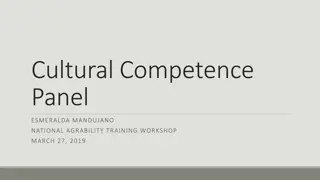Cultural Competence in LGBTQIA+ Community Healthcare
Explore the disparities faced by the LGBTQIA+ community in healthcare, learn terminology and cultural aspects, and identify the unique health needs. Discover barriers to access care, including stigma and discrimination, and gain insights on how nurses can provide culturally competent care to this population.
Download Presentation

Please find below an Image/Link to download the presentation.
The content on the website is provided AS IS for your information and personal use only. It may not be sold, licensed, or shared on other websites without obtaining consent from the author. Download presentation by click this link. If you encounter any issues during the download, it is possible that the publisher has removed the file from their server.
E N D
Presentation Transcript
L G B T Q IA xyz T he A lphabet S oup of C ommunity H ealthcare L G B T Q IA xyz T he A lphabet S oup of C ommunity H ealthcare Andrew Appello MSOM, L.Ac., RH(AHG), BSN, RN HealthyLivingAcupuncture@gmail.com NJSNA/IFN Convention Atlantic City, NJ October 12, 2017
Learning Outcomes: Nurses will: Note disparity of the LGBTQIA community Learn terminology and be introduced to LQBTQIA culture Discover the unique biopsychosocial health needs of the LGBTQIA community Improve culturally competent nursing care to the LGBTQIA community
National Institutes of Health October 6, 2016 -The director of the National Institute on Minority Health and Health Disparities announces (Perez- Stable, 2016): Sexual and Gender Minorities Formally Designated as a Health Disparity Population for Research Purposes Less access to care Higher burden of disease Stigma, hate-violence, discrimination
Barriers Preventing Access to Care Stigma Discrimination Violence Rejection by families and communities Inequality in the workplace Inequality in health insurance sectors Provision of substandard care Denial of care because of an individual s sexual orientation or gender identity (Ranji, Beamesderfer, Kates, & Salganicoff, 2014)
Lets Start with Cultural Competence Definition: Having the knowledge, abilities, and skills to deliver care congruent with the patient s cultural belief and practices (Purnell, 2013, p. 7)
Were Nurses! Implementing the American Nurses Association Standards of Care 8: Culturally Congruent Practice (Marion et al., 2017) Show RESPECT, EMPATHY, and EQUITY Self Assessment and Reflection Teach nursing colleagues (+ many others)
Cultural Proficiency Higher-Order concept that involves overcoming barriers of cognition and affect (de Chesnay, Hart, & Brannan, 2016) How do YOU feel?
My Story: A girl walks into the bar
Sexual and Gender Identity Labels, labels, labels . OR Fluidity *NOTE: Identity is not equal to culture and culture is not equal to identity but both inform LGBTQIA community nursing care!
Yin and Yang Yang Yin Light side of Dark side of the mountain the mountain
A Note on Stereotyping It is critical for practitioners to keep in mind that groups are composed of individuals we should not stereotype individuals in terms of group characteristics (de Chesnay, 2016, p. 4)
A Personal Account Stereotypes: Gay men are not handy or sporty Gay men are fabulous (sequins and glitter implied)
Introducing the ABCs of the Community How do you identify?
The Alphabet LGBT Lesbian Gay Bisexual Transgender
The New Alphabet LGBTQIA Lesbian Gay Bisexual Transgender Queer Intersex Asexual
The Expanded New Alphabet LGBTQQIAAP Lesbian Gay Bisexual Transgender Queer Questioning Intersex Ally Asexual Pansexual
Sexuality Three components (Fredriksen- Goldsen et al., 2014): Sexual identity Sexual attraction Sexual behavior
Sexuality and Labels MSM (Men who have Sex with Men) WSW (Women who have Sex with Women) MSMW, MSWM and WSMW, WSWM Terms introduced especially in research to convey that sexuality is a broad concept where behavior, desire, and identity do not always coincide (Young & Meyer, 2005-seminal source) The terms Gay and Lesbian often refer to Caucasians while MSM/WSW are more inclusive of people of color (Young & Meyer, 2005-seminal source) Gay/Lesbian etc. imply identity and community MSM/WSW speak to behavior
Coming Out! Can be: A celebration and liberating OR Painful and terrifying But definitely life changing RN interventions: Be supportive Listen Allow the client to come out when ready
Lesbian Culture WSW There are many types of Lesbians! Baby dyke The butch-fem divide Girl next door Lipstick lesbian Ursula *Note: Dyke can be used as a terrible insult or a reclaimed identity of empowerment. RN: Don t use!
Lesbian Culture Stereotype joke: What is a lesbian couple s second date? Renting a U-Haul to move in together (U-Haulin it) Opening a book store together Adopting a cat
Lesbian Health (Office on Women s Health, 2017) Lesbians and bisexual women are at an increased risk for: Obesity, smoking, stress. Breast, endometrial, and ovarian cancer Polycystic ovary syndrome Depression and anxiety Bacterial vaginosis Lesbians are less likely to get: Mammograms and clinical breast exams Cancer screening RN Interventions: Screen for all above risks Screening for heart disease, lung cancer
Reproductive One Womans Experience Be sensitive! Don t ask me about my donor You go broke or into debt because insurance does not cover it Nurse: Why doesn t your wife carry? She is younger and thinner Patient: Because carrying a child does not match her gender identity
Gay Culture MSM So many types of gay men! Bears Wolves Otters Twinks Jocks Cubs Boy next door
Know Your Positions Relevant to STD screening and risk Top = prefers insertive anal intercourse Bottom = prefers anal receptive intercourse Versatile (Vers) = enjoys topping and bottoming
HIV and MSM (Centers for Disease Control and Prevention, 2017a) Gay and bisexual men represent the most vulnerable group in the US 55% of the HIV infected population Risk of being diagnosed with HIV in a MSM man s lifetime: 1 in 6 All races 1 in 2 African-Americans 1 in 4 Hispanics/Latinos 1 in 11 Caucasians
HIV and MSM Youth (Centers for Disease Control and Prevention, 2017a) In 2014: 92% of new HIV diagnoses in the 18-24 age range were gay/bi men 27% of new HIV diagnoses in the gay/bi population were men age 18-24
STD Screening MSM Questions: Have you performed oral sex? Have you received anal receptive intercourse (bottomed)? Have you had multiple sexual partners? Has your sexual partner had multiple sexual partners? Assess for risky behavior and condom use. Is he knowledgeable about what constitutes risk?
STD Screening for MSM (Centers for Disease Control and Prevention, 2017c) Chlamydia: At least annual screening; every 3-6 months if at high risk Screen at site of contact regardless of condom use urethra or rectum Gonorrhea: At least annual screening; every 3-6 months if at high risk Screen at site of contact regardless of condom use urethra, rectum, or pharynx *High risk = 1. Those with HIV + persistent risky behavior or 2. Patients or their sexual partners with multiple partners
STD Screening for MSM (Centers for Disease Control and Prevention, 2017c) Syphilis: At least annual screening; every 3-6 months if at high risk Herpes: Type-specific serological test if status unknown or previously undiagnosed genital infection HIV: At least annually if status unknown or negative and patient or patient s sexual partner has had multiple partners since last test *High risk = 1. Those with HIV + persistent risky behavior or, 2. Patients or their sexual partners with multiple partners
STD Screening for MSM (Centers for Disease Control and Prevention, 2017c) Hepatitis B: Test all for HBsAg Hepatitis C: Test those born between 1945-1965 Test those with other risk factors: injection drug use, blood transfusion before 1992, long term hemodialysis, born to mother with Hep. C, intranasal drug use, receipt of an unregulated tattoo, and other percutaneous exposures Test annually + HIV infection
PrEP (Centers for Disease Control and Prevention, 2017b) Pre-Exposure Prophylaxis Truvada (tenofovir and emtricitabine) Taken daily to reduce the likelihood contracting HIV by more than 90% Much less effective when not taken daily and consistently and more effective when used with condoms and other safe sex methods
A PrEP Problem My story: The lawyer
A PrEP Problem MSM focus groups: Majority of men feel that PrEP use means they do not need to use condoms (Taylor et al., 2014) RN Interventions: Reinforce need for safe sex and that PrEP does not prevent other infection!
Bisexual MSMW or WSMW Identify as having sexual and romantic attraction to both genders Degree of attraction to each gender can vary Common misconception/stigma: You are just on your way to figuring out if you are gay or straight
Bisexual Bisexual women have higher rates of depression as compared to lesbians and heterosexual women (Bostwick, 2012)
Queer Dictionary definition: Abnormal or strange History of use as a word showing hate toward those who do not conform to dominant norms of gender and sexuality For LGBTQIA community: A reclaimed term of empowerment (inside of the community) The pride involved in not conforming to gender or sexuality expectations An identity Often has socio-political connotations RN recommendation: Do not use unless the client uses first!
Questioning Exploring one s gender identity and expression and/or Exploring one s sexual orientation Interventions: Provide a supportive and open environment Create a school-based or web-based LGBTQIA inclusive sex education program for all youth (Pingel, Thomas, Harmell, & Bauermeister, 2013)
Intersex Those who have primary and/or secondary sex traits of both male and female genders It is not socially acceptable to use the term hermaphrodite Disorders of Sex Development (DSD) A controversial term Research is insufficient concerning the benefit of early gender assignment surgery (Diamond & Garland, 2014) Recommendation is to delay cosmetic surgery until the patient can appropriately consent (Diamond & Garland, 2014)
Ally A cisgender, heterosexual person who supports LGBTQIA social equality (Cisgender: Gender identity = socially recognized sex)
Asexual A sexual orientation One who feels lack of attraction or desire for a sexual partner Differs from the practice of celibacy
Pansexual AKA omnisexual Those who have romantic or sexual desire for others of all genders and sexuality
Trauma? Research by Hatzenbuehler and McLaughlin (2014) Tested LGB youth exposed to structural stigma Structural stigma = stigma encoded into state legislation. Example: no marriage equality laws Conclusion: LBP youth living in states with structural stigma experience cortisol blunting reminiscent of post-traumatic stress
Healthy People 2020 LGBT Disparity (U.S. Department of Health and Human Services, 2017) Increased rate of suicide and homelessness (LGBT youth) Increased rate of HIV infection (gay men) Especially men of color Increased risk of obesity (lesbian and bisexual females) Less likely to have preventative cancer services (lesbians) Increased use of tobacco, alcohol, and drugs (all LGBT)
Healthy People 2020 LGBT Disparity (U.S. Department of Health and Human Services, 2017) Increased HIV/STD, victimization, mental health issues, suicide (transgendered people) Less likely to have health insurance (transgendered people) Increased isolation, lack of social services, culturally competent providers (elderly LGBT)
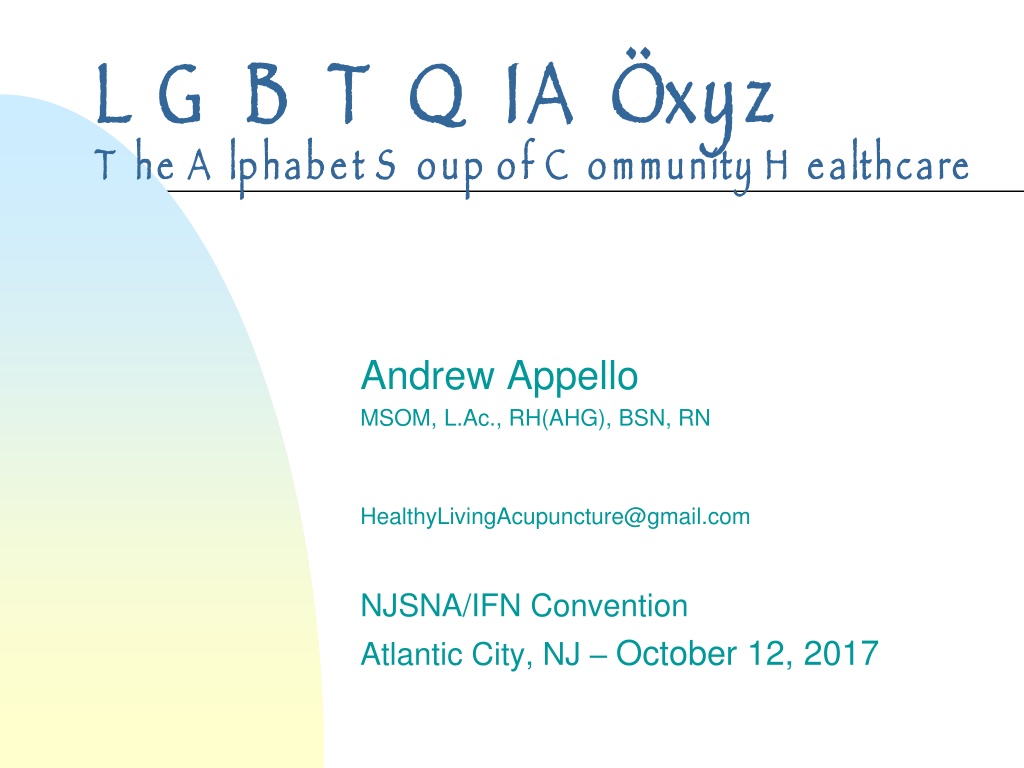
 undefined
undefined





